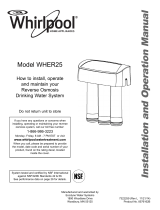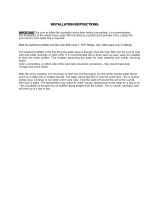
Troubleshooting Guide
REVERSE OSMOSIS SYSTEM CARE GUIDE MODEL NOs. WHER12 and WHER18
1, AT LEAST every 6 months, replace the prefilter and postfilter cartridges or when yellow LED flashes.
2. Replace the RO membrane cartridge when the percent rejection of total dissolved solids (TDS) is less than shown in the specifications
(see B, below) or when red LED flashes.
3, Replace the batteries once per year.
If any of the following occur before the 6 months, replace as directed.
A. Slow Making of Product Water: Replace the prefilter cartridge. Ifthe production rate does not improve, replace the post filter cartridge
and RO membrane cartridge.
B. High Total Dissolved Solids (TDS) in Product Water: Send treated and untreated water samples to a water analysis lab for testing.
tt is important to test both the treated and untreated water to determine system performance. If the TDS is not within the system's
performance guidelines, replace the prefilter, post filter and RO membrane cartridges.
C, Chlorine Taste and/or Odor: Replace the prefilter, post filter and RO membrane cartridges,
OTHER TROUBLESHOOTING
CORRECTIONPROBLEM
Chlorine taste and/or odor
in the RO product water
Other taste and/or odor
CAUSE
The ppm of chlorine in your water supply
exceeds maximum limits, and has de-
stroyed the RO membrane.
The prefilter is no longer removing chlo-
rine from the water supply.
Post filter expended.
RO membrane cartridge expended.
Contamination in product water storage.
Water supply to the RO system not with-
in specifications.
tf the water supply contains more than 2.0 ppm of chlorine, addi-
tional filtering of the water supply to the RO is needed. Correct this
condition before doing maintenance on the RO system.
Replace the prefilter, post filter and RO membrane cartridges.
Replace the post filter cartridge. If taste and odor persists, replace
the prefilter cartridge and RO membrane cartridge.
Use sanitizing procedures. Replace the post filter cartridge.
System makes product Check water pressure, if below listed requirement, contact a li-
water too slowly censed plumber. Precondition the water, etc., as needed to con-
form, before doing maintenance on the RO system.
Prefilter or RO membrane cartridges Replace the prefilter cartridge. If rate does not increase, replace
plugged with sediments, the postfilter cartridge and RO membrane cartridge.
System delivers lower Storage tank air-charge less than 5 - 7 Open RO faucet and draintank untilflowslowstoadrip. Keepfau-
amount of product water psi when tank is empty, cet open and check tank pressure. If low, pressurize to 6 psi. Close
than usual faucet to refill the tank.
High total dissolved solids Water supply to the RO system not with- Increase water pressure, precondition the water, etc., as needed
(TDS) in product water - in specifications, to conform before doing maintenance on the RO system.
flashing red LED
RO membrane cartridge expended. Replace the prefilter, postfilter and RO membrane cartridges, flow
control, and screen.
Water leaking from faucet Drain side of faucet airgap (3/8" tubing) Inspect and eliminate restriction or plug. Refer to installation
airgap hole plugged, restricted, or incorrectly con- instructions for proper drain connection.
nected to drain point.
Continual water flow to Check valve or automatic shutoff as- Clean, repair or replace as needed.
drain sembly plugged, restricted or parts
worn
Faucet LED indicator light Batteries dead. Replace with new batteries.
does not function after
battery change Batteries installed incorrectly. Install batteries correctly.
Static protection device was not dis- Remove batteries for a minimum or one hour and then reinstall.
charged.
Continual water flow to Missing flow restrictor in red drain tube Replace flow restrictor.
drain and no product wa- or its corresponding port.
ter Check ball assembly not seating. Clean or replace check ball assembly.
NOTE: Sanitizing is recommended after servicing inner parts of the system. See "Sanitize,
Pressure Test and Purge" section.
2O






















